Since the appointment of former Ajax and Borussia Dortmund manager Peter Bosz in the summer after the departure of Manchester United legend Ruud van Nistelrooy as head coach, PSV Eindhoven have been absolutely flying domestically to start the new Eredivisie season. Ten matches into the campaign, they have won every single match, sitting on 30 points with both the best attack and defence in the Dutch top flight.
Instead of looking at the 59-year-old Dutchman’s tactics, this piece will still highlight three players who have become vital cogs in the engine of this PSV side, using both statistics and examples to illustrate what they have been able to contribute to this high-flying Eindhoven side. This tactical analysis will be like a scout report in some regards, talking slightly in detail about what each of these players has brought and how they have fit into the style of play that Peter Bosz has looked to implement at PSV Eindhoven.
Luuk de Jong, ST, 33-years old
Without a doubt, the player that has made the biggest impact since Peter Bosz’s appointment in the summer has been 33-year-old Dutch striker Luuk de Jong. The striker rejoined the club from Spanish side Sevilla in the summer of 2022, but this season is where he really has begun to make his mark back in Eindhoven.
His eight goals scored this season is the third-highest in the Eredivisie, while his five assists is the joint-most in the division. He has also taken the most shots of any other player in the Eredivisie this season, while he also has the most touches in the penalty area of any other player. All in all, de Jong has become a penalty box poacher for Bosz’s side, and his leadership has also been huge, with the Dutch striker being the club captain.
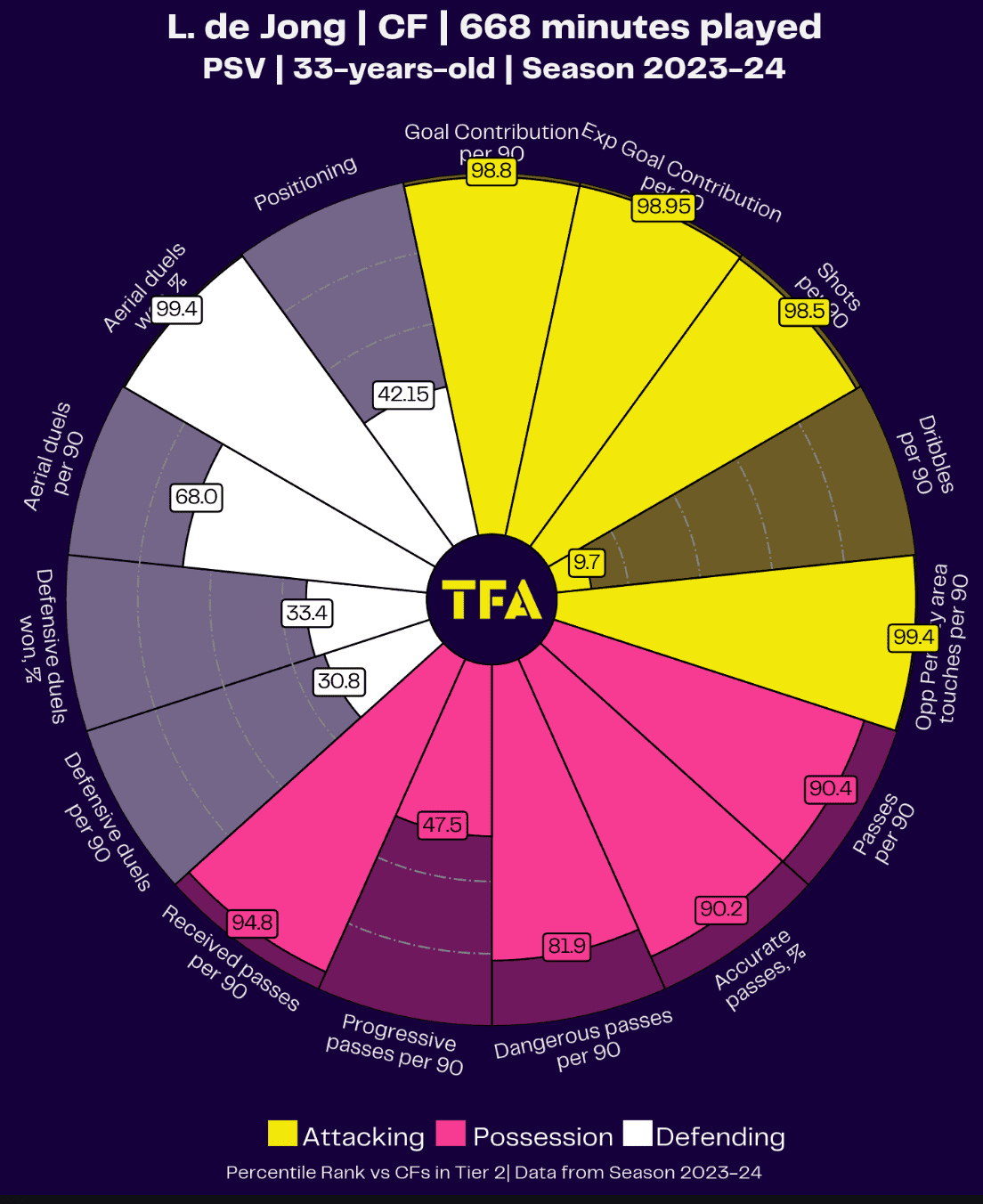
The pizza plot above shows where de Jong has excelled and been slightly below average this season for PSV in the Eredivisie compared to other players in his position. As we can see from the graphic, from an attacking perspective, the 33-year-old striker has been absolutely lethal in front of goal. Outside of dribbles per 90, de Jong essentially has been one of the best strikers in the Dutch top flight from a pure goalscoring and attacking perspective.
When looking at the possession statistics, de Jong also ranks highly in a majority of these categories as well. Linking with his presence inside the penalty box, de Jong ranks as one of the best strikers in the Eredivisie in regards to received passes per 90 minutes, while his ability on the ball and distribution is also well above average this season, as illustrated by his rankings in the other metrics and his five assists on the season.
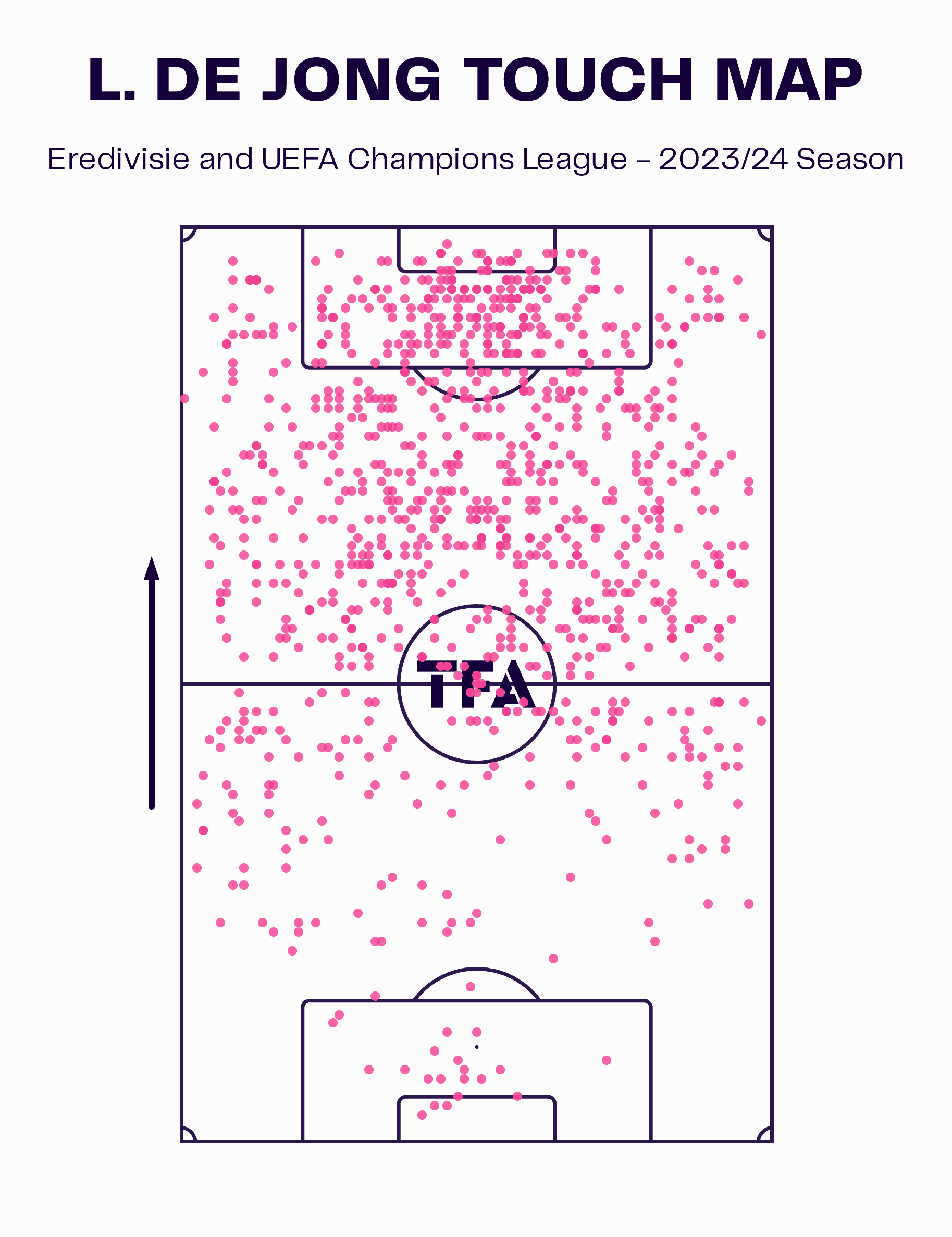
The data viz graphic above shows the heat map of Luuk de Jong this season in both the Eredivisie and UEFA Champions League for PSV Eindhoven this season. As we can gather from the data above, the 33-year-old striker normally gets on the ball within 30 yards of the goal, though he is most proficient when allowed to find the ball in the box, with him usually being clinical in front of goal.
However, the Dutchman does not have the highest percentage of shots on target when compared to other strikers in the Eredivisie. Still, his 43% on target rate ranks as one of the top five in the division for centre-forwards. Something that de Jong is elite at is his goalscoring ability with his head, with his 13 head shots the highest total among all players in the Eredivisie this season, with his three headed goals also the most.
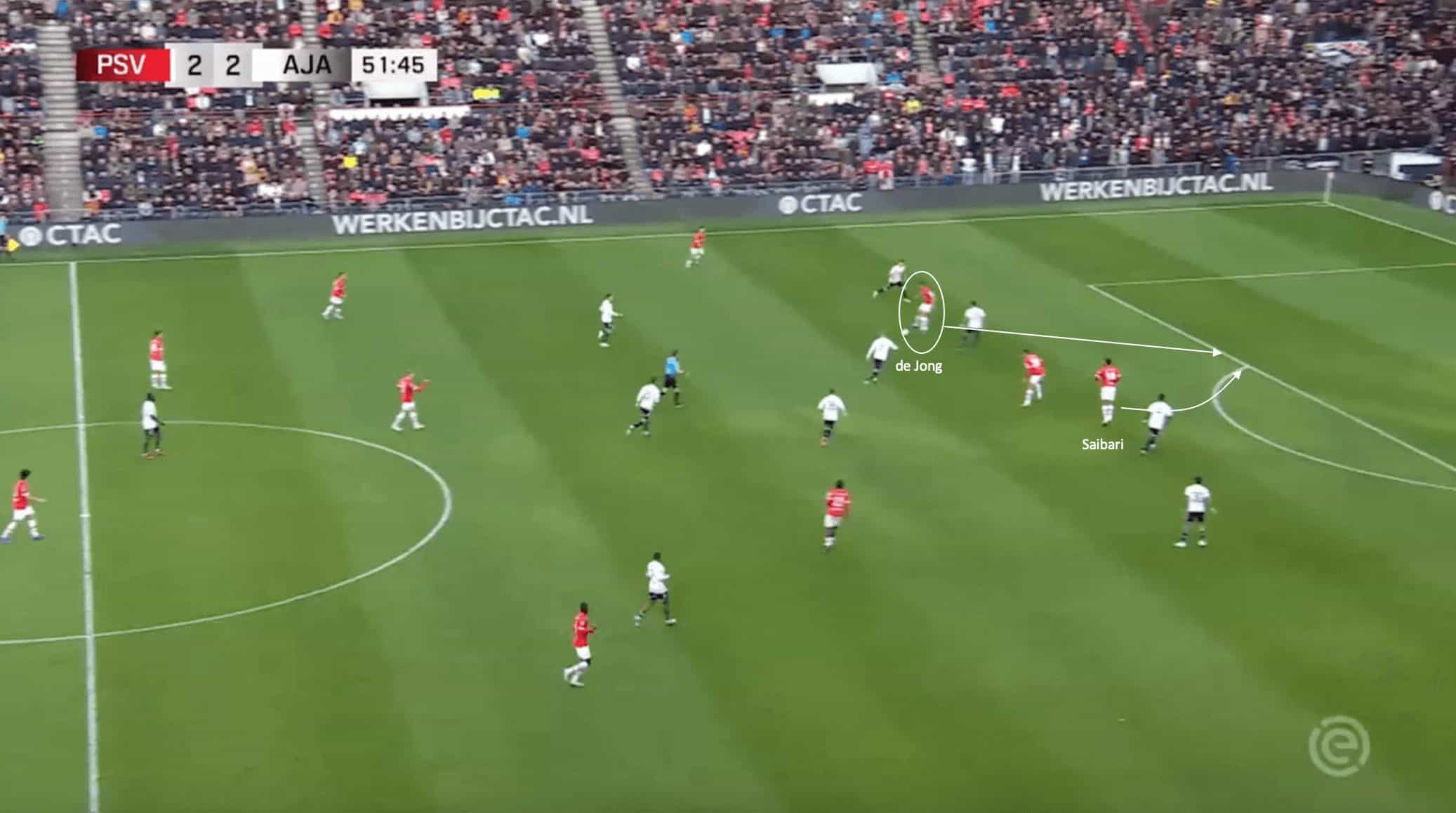
The image above shows an example of de Jong’s ability with his back to goal, as well as highlighting his vision and tendency to turn provider at times. In this phase of play above from PSV’s recent league victory against Ajax, the 33-year-old striker is positioned outside the penalty box, with two attackers in higher positions in more favourable positions to goal. The ball is played forward to him by midfielder Jerdy Schouten, with him almost immediately pressured by two Ajax defenders on his back.
However, de Jong scanned his surroundings before receiving possession, noticing the two attackers in more advanced positions hanging out on the edge of the Ajax backline. This positioning and vision allowed him to play a one-touch pass into the path of Ismael Saibari, with the winger able to slot home to give PSV the lead.
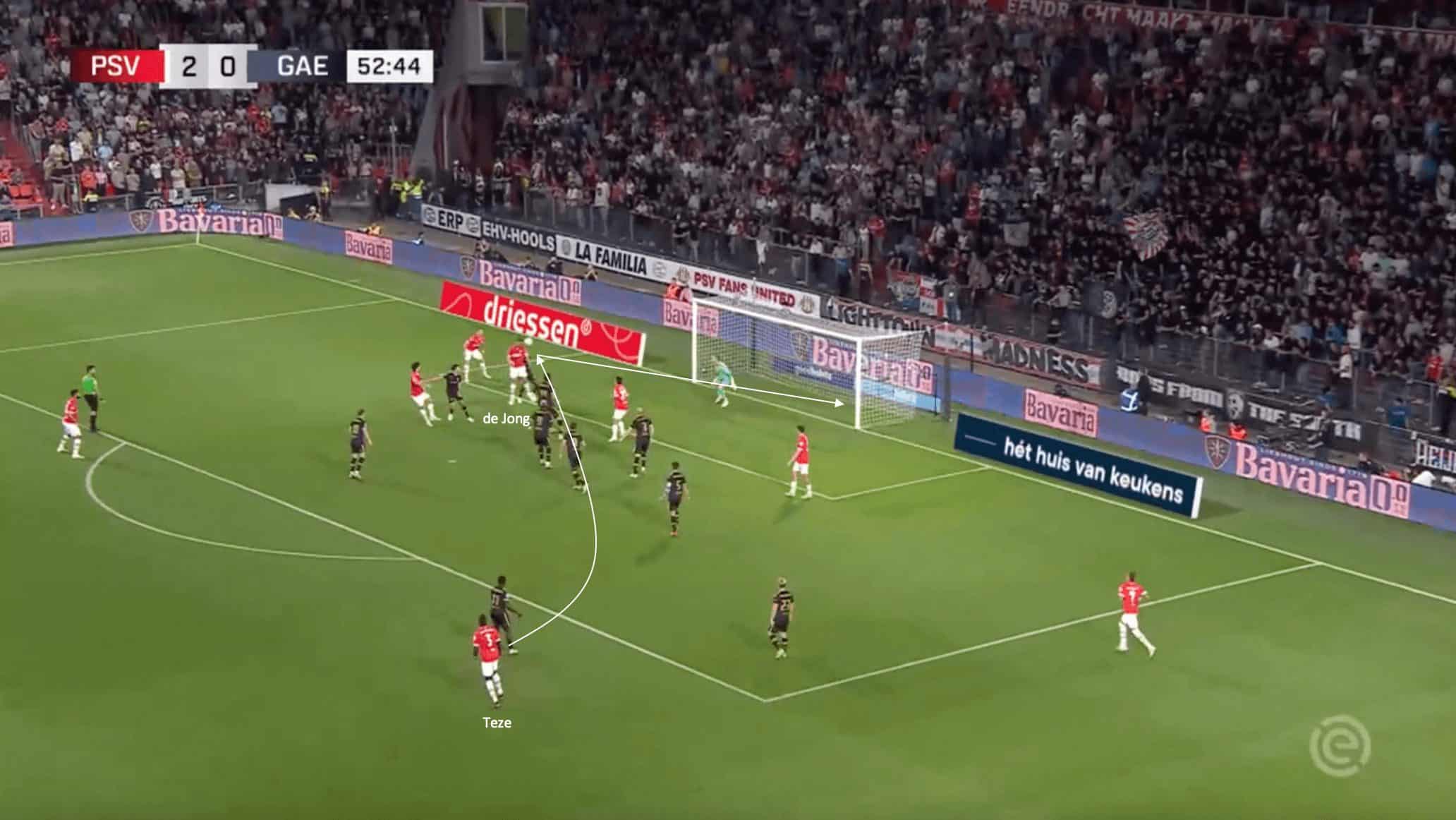
The image above shows an example of the aerial presence that Luuk de Jong possesses and another reason why he is one of the first names on the team sheet from Peter Bosz. In this phase of play above, the Dutch striker managed to slip between two Go Ahead Eagles defenders, with a beautiful ball whipped towards him by defender Jordan Teze.
The 33-year-old striker was able to leap well above the Go Ahead Eagles defenders, guiding the ball into the far corner past the goalkeeper. This displays not only the aerial ability of de Jong but also his vision and recognition of space, as well as the ability to perfectly time his runs to get onto the ends of these balls into the box from wide areas.
When looking at the start that PSV Eindhoven have had under Peter Bosz, it is a no-brainer to look past the impact Luuk de Jong has had to help get the Eredivisie side to where they currently sit in the table.
Joey Veerman, CM, 24 years old
Another player having a very impactful season so far under Peter Bosz at PSV Eindhoven is 24-year-old Dutch central midfielder Joey Veerman. The two-time Dutch international joined the Eindhoven club in January of 2022 from fellow Eredivisie side Heerenveen, with the midfielder having a perfect start to life under Peter Bosz.
Compared to other Eredivisie central midfielders this season, Veerman leads the way with four assists while also leading the way with 3.05 expected assists. The 24-year-old also leads the Eredivisie in through passes and smart passes while being second in the Dutch top flight in progressive passes. These rankings highlight the Dutch midfielder’s ball distribution, more specifically, his ability to progress play for PSV from a deeper-lying position.
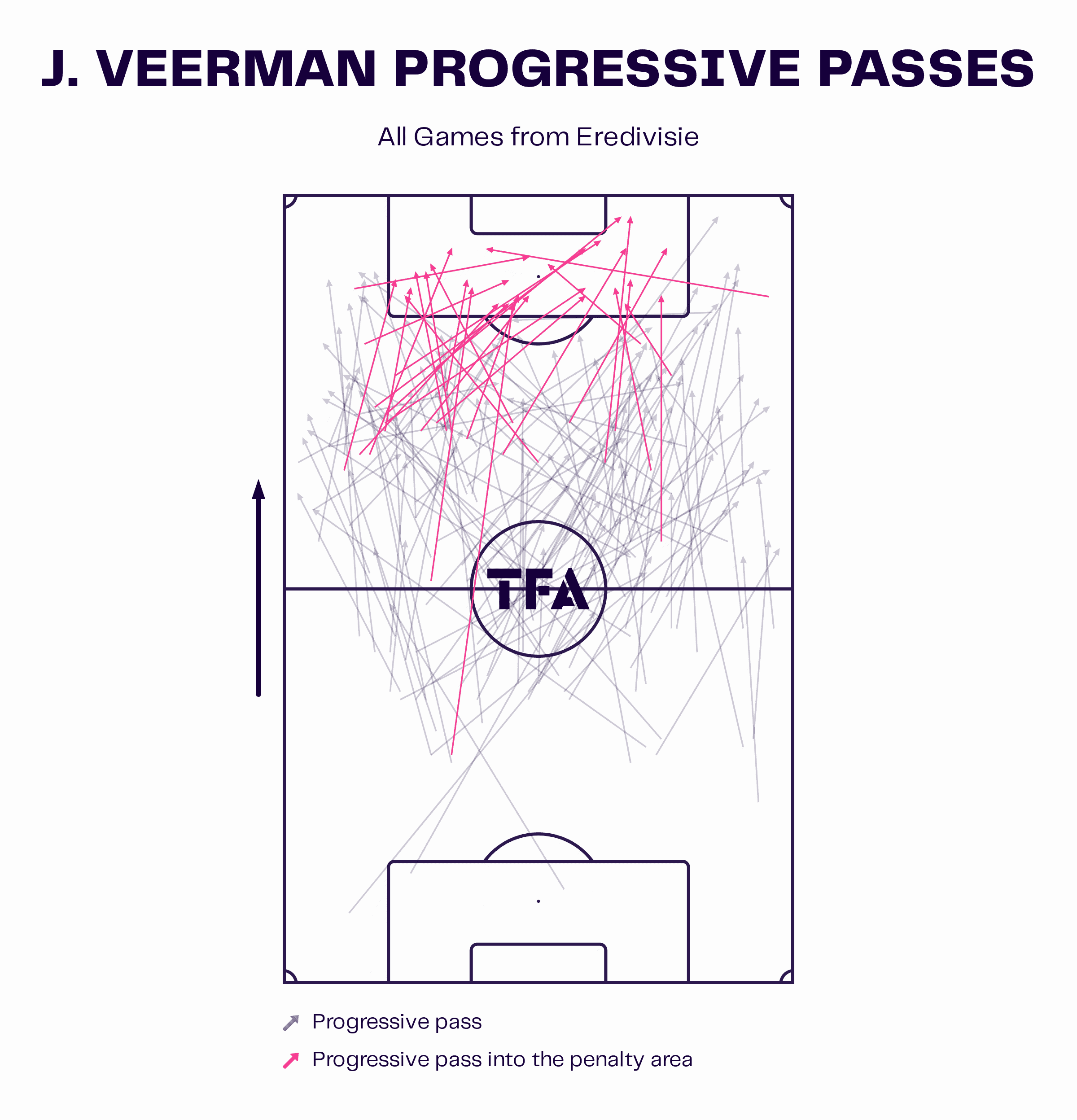
The data viz graphic above shows the progressive passes completed by Joey Veerman this season in both the Eredivisie and Champions League, with the ones highlighted in pink being progressed into the penalty area. As we can see from the graphic, Veerman has had a massive impact on ball progression for PSV Eindhoven from these deeper-lying midfield areas. However, he tends to progress furthest forward in the double pivot and acts as more of the #8 in Bosz’s preferred 4-2-3-1 system he has used this season at the Dutch club.
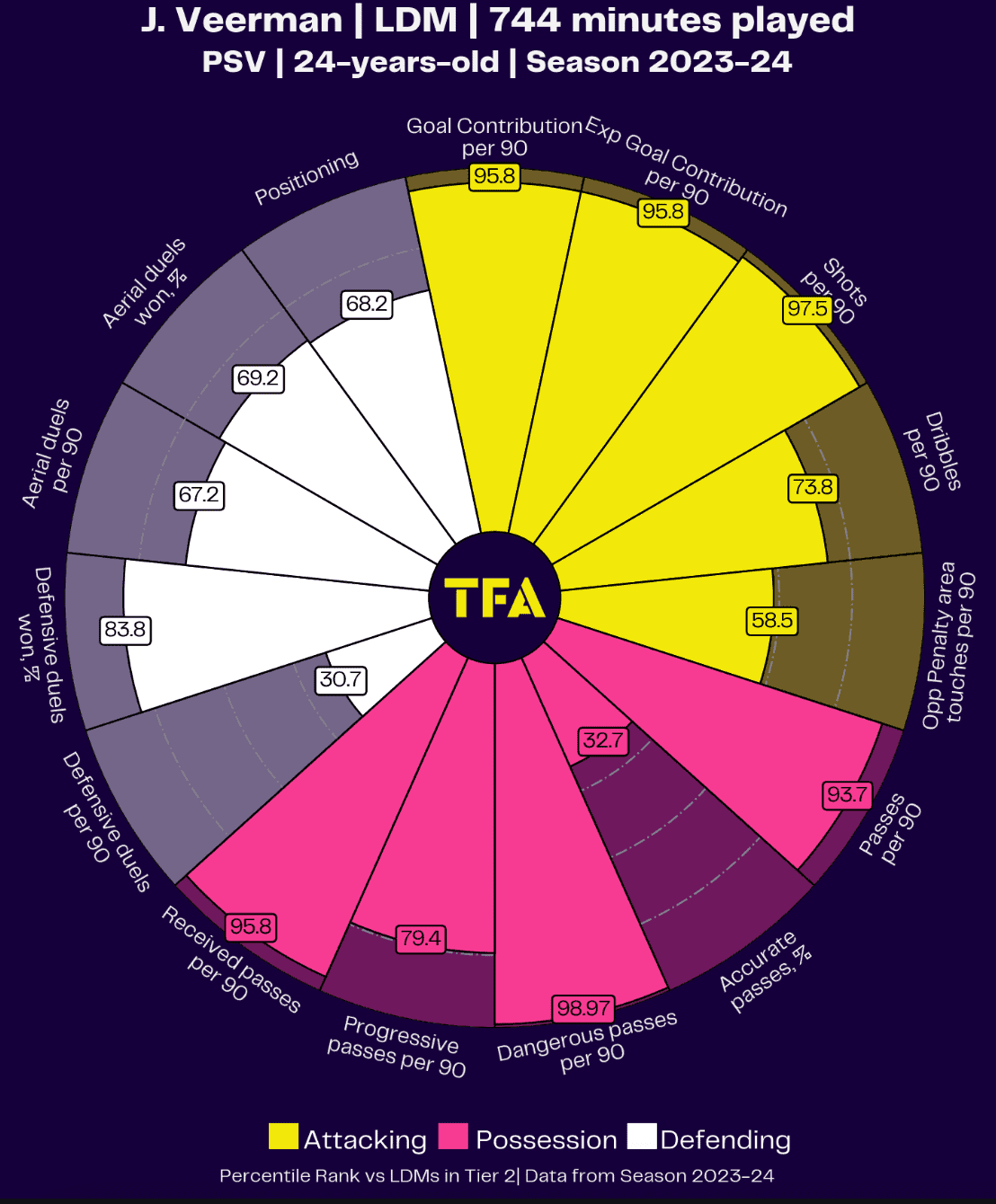
The pizza plot above shows the percentile rankings of Joey Veerman compared to other players in his position in the tier 2 leagues around Europe this season. As we can gather from this pizza plot, Veerman ranks very highly in the possession metrics, with this being the area of his game that he excels at most, further solidifying his standing as one of the best ball-playing central midfielders in the Eredivisie thus far in this current campaign.
With him ranking highly as well in goal contributions per 90, expected goal contributions per 90, and shots per 90, it also highlights his tendency to play more as a #8 for Bosz’s side, with it standard for the 24-year-old to find himself in more advanced attacking positions where he can get shots off from favourable positions. Though he finds himself more middle of the road for players in his position from a defensive position, he does rank near the top in defensive duels won %, showing his capability from a defensive standpoint if situations arise to stop counterattacks or prevent ball progressing actions from opposition midfielders.
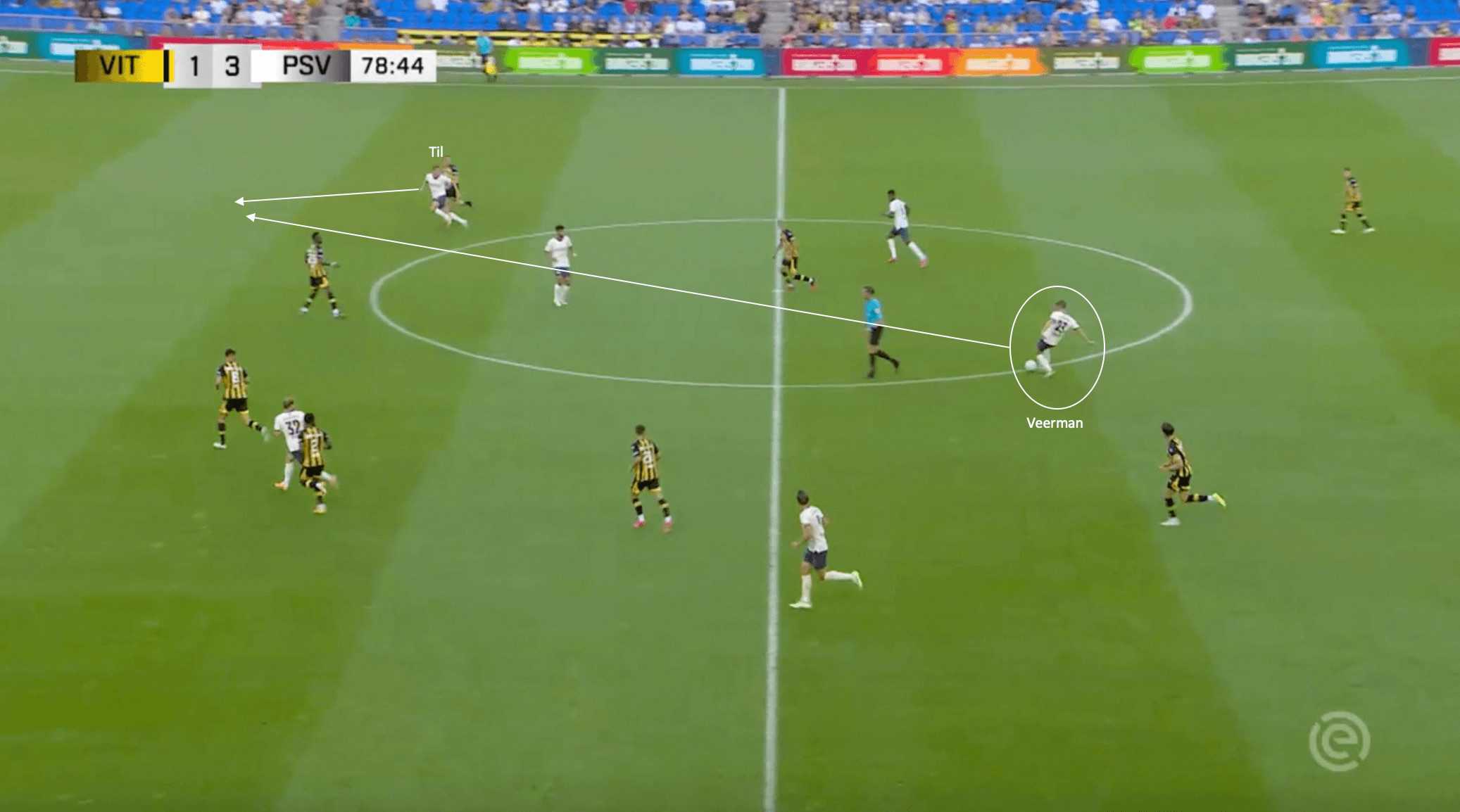
The image above shows an example of the vision that Joey Veerman possesses, as well as his range of passing from deeper lying positions. In this phase of play above from a recent league match against Vitesse, the 24-year-old is in possession in the defensive half of the pitch and afforded time on the ball, with no Vitesse player looking to pressure him. After receiving possession and lifting his head, he can spot the run of Guus Til and plays a perfectly weighted pass into the path of the Dutch attacking midfielder, breaking the opposition’s midfield and defensive lines as a result.
This allows Til to bear down on goal in a 1v1 situation with the goalkeeper before squaring it across goal for an easy tap-in. Though Veerman does not directly get the assist, he instead gets the second assist; this example highlights the ball progression ability he has displayed often this season from a relatively deeper position in midfield. The 24-year-old Dutch international has been pulling the strings often for Peter Bosz’s side and has formed a formidable midfield partnership with summer signing Jerdy Schouten, who arrived from Serie A side Bologna during the transfer window.
Olivier Boscagli, CB, 25-years old
The final player this analysis will look at is 25-year-old France youth international centre-back Olivier Boscagli. The Monegasque has formed the best central defence in the Eredivisie with former RB Salzburg central defender André Ramalho, but where Boscagli has really shone this season is his ball progression from the centre of defence.
In terms of statistics, Boscagli has been one of the best ball progression centre-backs in the Eredivisie this season. His 679 total passes ranks second of all Eredivisie defenders, with his 74.34 average passes per 90 minutes the highest total in the Dutch top flight. The 25-year-old defender also has 140 progressive passes this season, the 4th highest total in the Eredivisie. The most interesting number, however, is the number of passes Boscagli has played to the final third. His 161 is the most in the Eredivisie, over 30 more than the next-highest defender on the list.
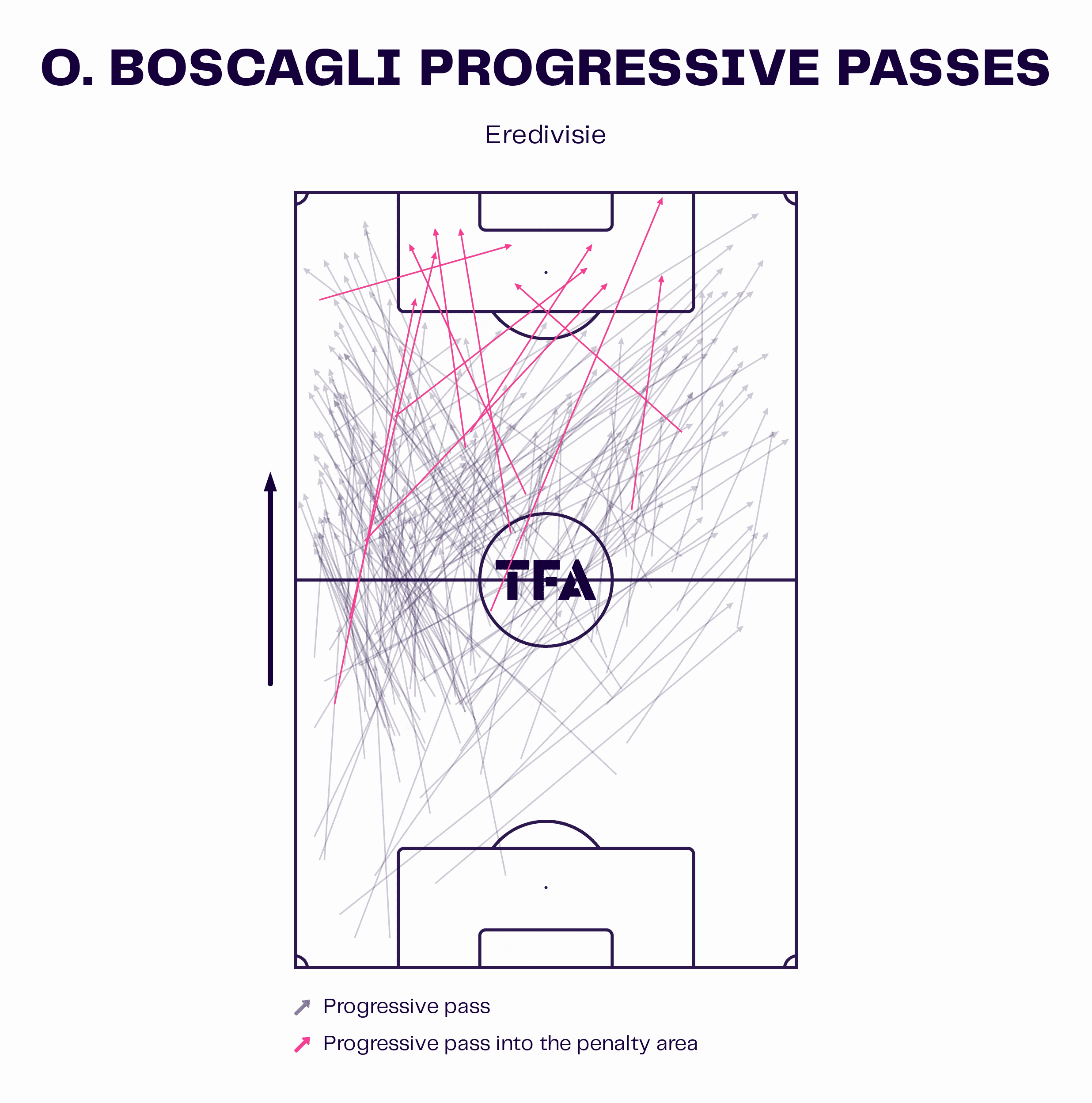
The data viz graphic above shows the progressive pass map of Olivier Boscagli this season in both the Eredivisie and Champions League. As we can see from the graphic, Boscagli’s ball progression into the final third has played a large part in the success that PSV have had this season in Peter Bosz’s first season in charge. With the Dutch manager preferring to play a more aggressive front-foot defensive line, Boscagli has managed to find himself in more attack-minded positions, and it has managed to work for the better this season.
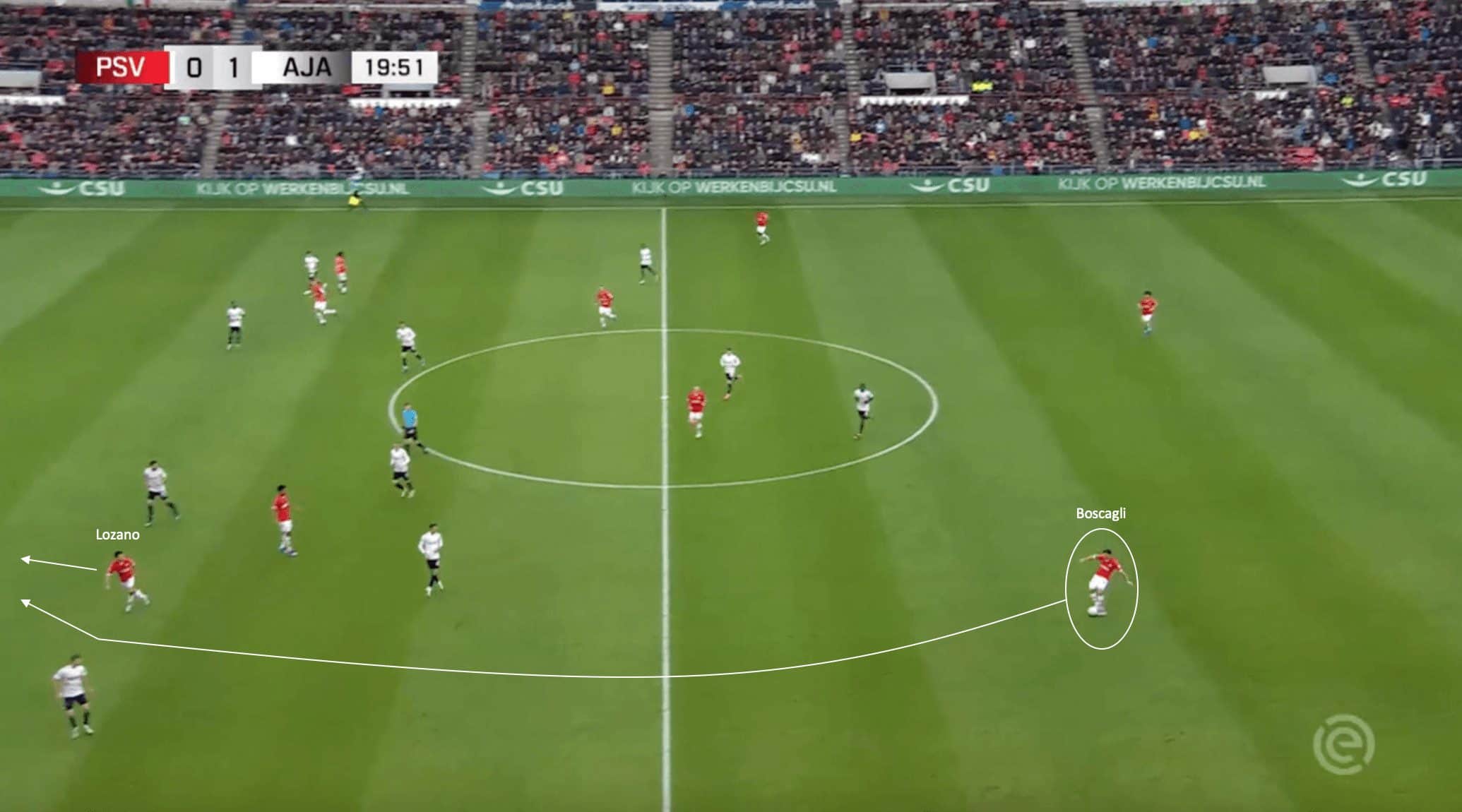
The image above shows an example of the progressive passing range that Olivier Boscagli has possessed this season. In the phase of play above in their last league match against Ajax, the central defender is in possession, with both PSV central defenders pushing up into the midfield while in possession. The Monegasque central defender spots the run of Mexican international Hirving Lozano and can play a perfectly weighted pass behind the Ajax defence and into the winger’s path.
This resulted in a goal for the Mexican, with the assist coming from Boscagli, who could penetrate the entire Ajax side with a single pass. Compared to his centre-back partner, Boscagli displays more calmness and quality in possession. At the same time, Ramalho has been able to be more of a destroyer in the backline, getting stuck into tackles and allowing Boscagli more freedom to roam into these midfield positions while in possession.
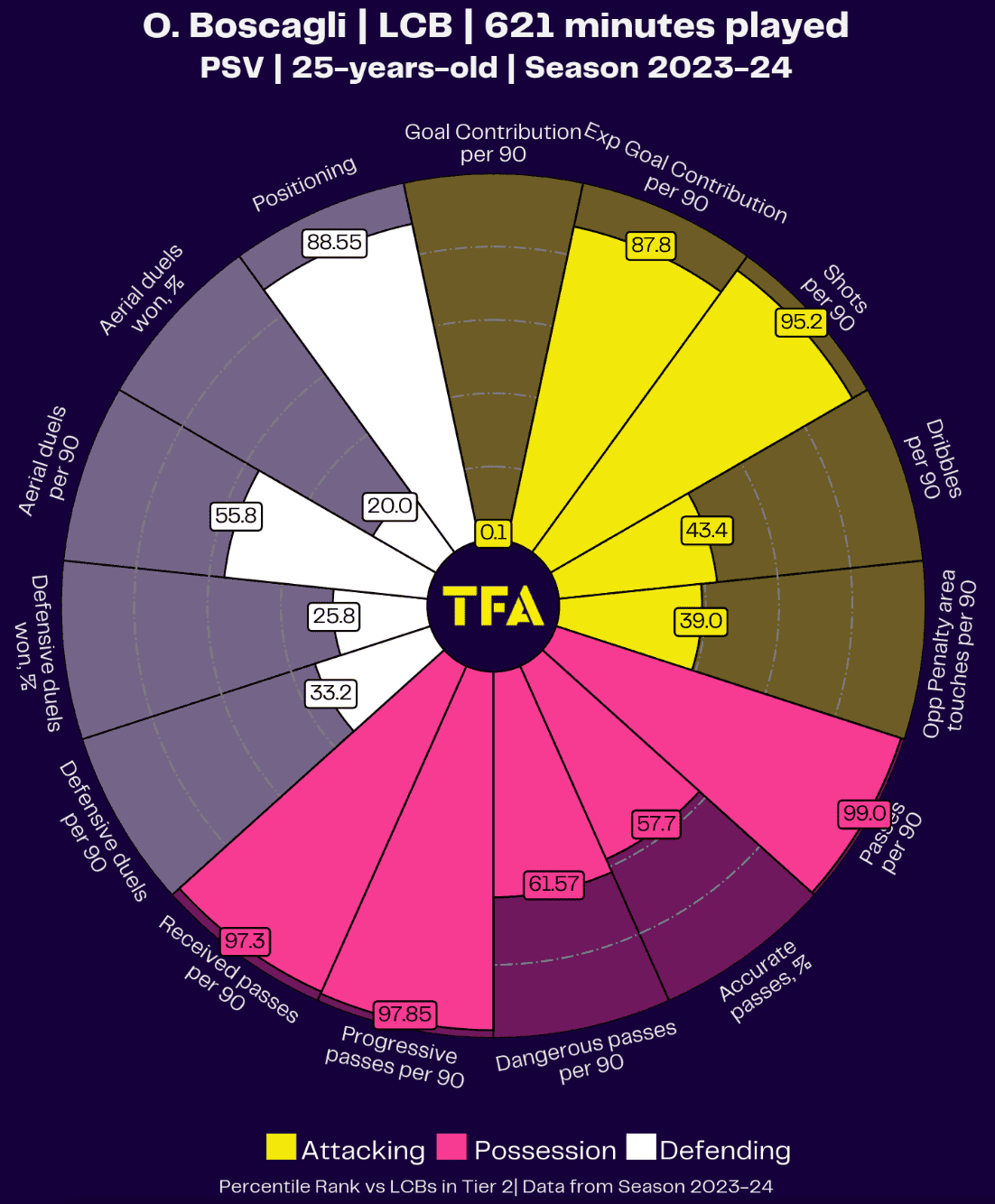
The pizza plot above shows the percentile ranks of Olivier Boscagli against other centre-backs in similar leagues to the Eredivisie. As we can see from the data, the 25-year-old’s possession metrics are very high, making him one of the best central defenders on the ball at this level of the league. He also ranks near the top in several attacking metrics, showing his ability to progress the ball into the final third using long-range passing.
While he may not rank that highly on the defensive side of the ball, he still is a capable defender, with André Ramalho able to support that side of his game a bit more, something which makes them a formidable centre-back partnership and one of the many reasons why they have led PSV Eindhoven the best defence in the entire Eredivisie so far this season.
Conclusion
As this tactical analysis and scout report has shown, PSV Eindhoven have had an unbeaten start to the domestic season under new manager Peter Bosz. While a lot of deserved credit can go to the tactics the 59-year-old Dutchman has been able to employ, the three players covered in this analysis have also played a large part in the success of the Dutch side thus far this season.





Comments